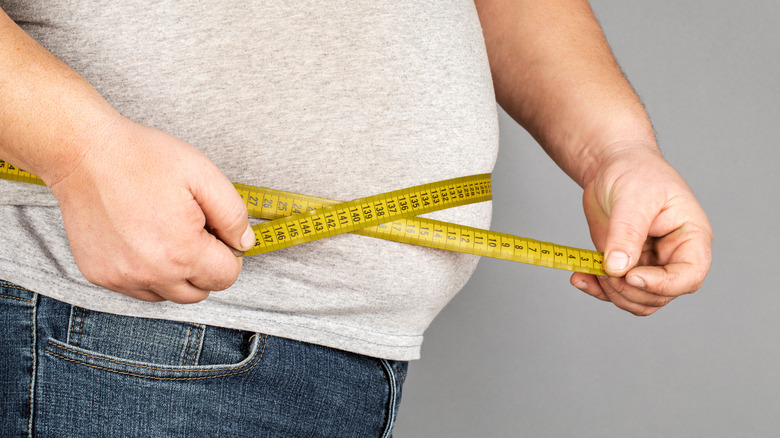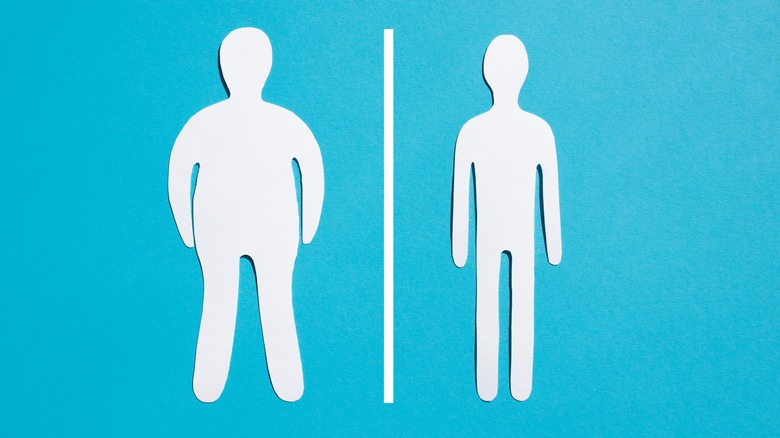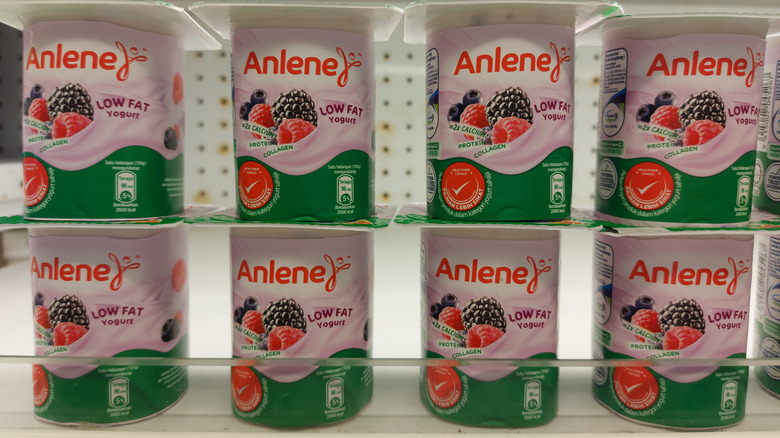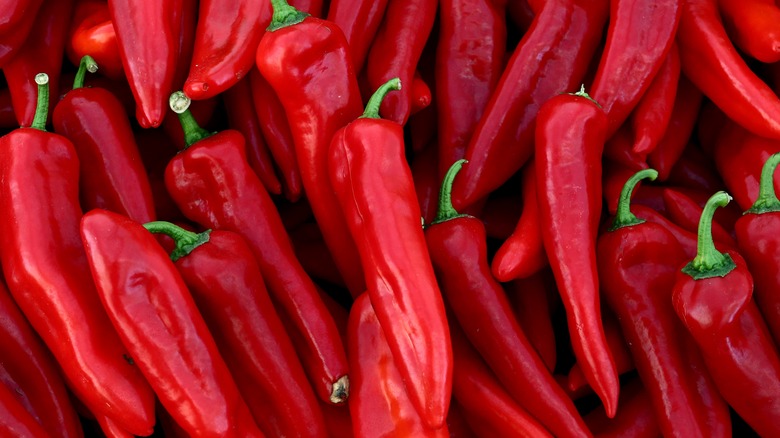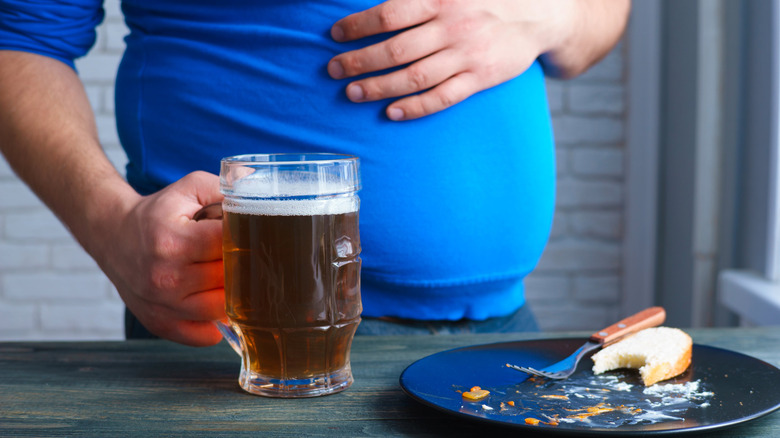Myths You Should Stop Believing About Belly Fat
If you have fat in your midsection, you might be looking for ways to lose it. That's not a bad idea because if you have excess weight around your belly, you also have the increased health risks that come with it. The Cleveland Clinic explains that extra fat in your abdomen can raise your risk of developing diabetes, fatty liver disease, heart disease, high cholesterol, some types of cancer, and polycystic ovary syndrome. A waist measurement of 35 inches for women and 40 for men is considered to be high risk.
But before you search the internet for ways to get rid of belly fat, you should know that there are plenty of myths surrounding how to get it done. In fact, some of these myths straight-up don't work, and the last thing you want to do is invest time and energy in a plan that is only going to cause frustration.
Crunches will banish belly fat
Crunches, or any other kind of exercise that targets your core, might tighten your ab muscles, so don't they have what it takes to burn fat? In fact, spot reduction is a myth, according to Live Science. The only way to reduce fat around your midsection is by increasing the overall amount of exercise you do. Sammy Margo, a physiotherapist, told Live Science that the reason is somewhat complicated, but it all comes down to how your body uses fat for energy. Simply put, your body uses fat from everywhere for energy, not just in the area you happen to be exercising.
If exercises targeting your abdomen don't burn belly fat, which ones do? Any exercise that burns fat will help reduce the fat around your midsection. You will lose belly fat when your overall percentage of body fat decreases. High-intensity interval training (HIIT) is a nice option because it doesn't take a lot of time. That said, any kind of cardio, or aerobic activity, will do.
Belly fat is like other body fat
Your body contains two kinds of belly fat: visceral and subcutaneous. WebMD explains that subcutaneous fat is just below the surface of your skin. Visceral fat, on the other hand, resides deep in your abdomen. Visceral fat is linked to serious medical conditions including heart disease, high cholesterol, and blood pressure, Alzheimer's disease, and type 2 diabetes.
The only definitive way to know if you have any visceral fat is through an imaging scan, which can be expensive. However, you can get a rough estimate of how much you have by knowing your body mass index (BMI). The easiest way to do this is with an online calculator. WebMD points out that a BMI of 30 or greater is considered overweight and that could be a sign that you are carrying visceral fat. You get rid of visceral fat the same way you get rid of subcutaneous fat.
Reducing your fat intake will reduce belly fat
It might sound logical that if you reduce your fat intake, you'll lose fat. However, this isn't exactly how the body works. The University of Delaware points out that your body needs certain kinds of fat, and increasing the amount of unsaturated fat in your diet could help you lose weight (along with other health benefits). Your body also needs some fat to absorb important nutrients like vitamins A, D, E, and K.
It is worth noting that while increasing the number of low-fat foods in your diet seems like a good idea, it can sabotage your weight loss efforts because many of these foods are high in sugar and carbohydrates. Monounsaturated fats and omega-3 fats are considered the healthiest form of fat, and the best sources of fats come from avocados, eggs, fatty fish, nuts, and olive oil. You only need to eat fish twice a week to reap the benefits of omega-3 fatty acids.
Certain foods can burn (or melt) belly fat
You've probably heard a few foods, like pistachios, green tea, carrots, and hot peppers being described as fat burners, but, unfortunately, this is a misnomer. The reason some foods are labeled this way is because of their effect on your metabolism. Men's Health reports that this process is called a thermic effect, and while it does happen, the overall increase is negligible and temporary. That doesn't mean you can't take advantage of this effect, however. Caffeine can increase your metabolic rate anywhere from 3% to 13%, which can cause you to burn a few more calories than you normally would. Green tea contains the antioxidant epigallocatechin gallate (EGCG), which can increase fat burning (via Healthline).
Some foods touted as fat-burners are also beneficial for your health. Healthline reports several so-called fat-burning foods are healthy because they contain beneficial ingredients, like protein and fiber. For example, fatty fish and eggs are a few foods that may help increase your metabolism.
Beer is the only cause of belly fat
You've probably heard the term "beer belly" in relation to someone who has fat around their waistline. It's true that consuming too much beer — or any other kind of alcoholic drink — could cause a buildup of fat around your midsection, but only if you drink it in excess. If you consume more calories than you burn, your chances of developing a fat gut are going to increase because your body has to store the excess energy somewhere. And this will happen regardless of what you eat or drink (via WebMD).
However, alcohol makes the situation worse because your body will burn alcohol calories before it burns any other kind of energy store. That's because alcohol is a toxin, and when your body is metabolizing alcohol calories, it basically shuts down any other fat-burning process. In addition, it throws your hormones out of whack, which can make it harder to lose weight and get proper sleep, which can also have a negative impact on your weight loss efforts (via Business Insider).

